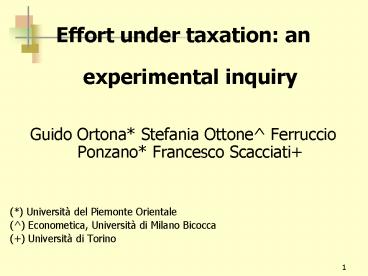Effort under taxation: an experimental inquiry - PowerPoint PPT Presentation
1 / 12
Title:
Effort under taxation: an experimental inquiry
Description:
Experimental Evidence Sutter and Weck-Hannemann (2002); L vy-Garboua (2005) ... BUT the tax revenue was lost for tax payers or assigned to other non-deserving ... – PowerPoint PPT presentation
Number of Views:30
Avg rating:3.0/5.0
Title: Effort under taxation: an experimental inquiry
1
- Effort under taxation an experimental inquiry
- Guido Ortona Stefania Ottone Ferruccio Ponzano
Francesco Scacciati - () Università del Piemonte Orientale
- () Econometica, Università di Milano Bicocca
- () Università di Torino
2
Related Literature
- Workers effort decreases in presence of taxation
- Experimental Evidence ? Sutter and
Weck-Hannemann (2002) Lévy-Garboua (2005)
Masclet et al. (2005) Swenson (1988) Sillamaa
(1999) - BUT the tax revenue was lost for tax payers or
assigned to other non-deserving subjects ? no
relevance of the use of the tax revenue
(Leviathan notion of State) - Our previous experiments (WP 77 of the Dep. POLIS
of the Università del Piemonte Orientale, Oct.
2006) if the tax revenue used to produce a
welfare state, the effort does not decline
3
Our previous experiment
- Relation between effort and taxation in presence
of a non-Leviathan state universalistic
insurance and other universalistic public goods
compared with a State of Nature where there is
no State. - Participants were requested to carry out a
secretarial task - Two contracts were submitted, one corresponding
to the State of Nature (SN) and the other to the
Welfare State (WS) - State of Nature ? there is the risk of loosing
the whole wage or half of it, and there are no
taxes, insurance and public goods - Welfare State ? there is the same risk of loosing
the whole wage or half of it, a proportional
income tax, a (high but not full) insurance and a
public good - Note we avoided terms like "welfare state",
"cooperation", etc.
4
Possible biases
- Our result is coherent with the theoretical model
of Bird (J. of Public Economics, 2001) the
welfare state may enhance productivity due to
risk reduction - However, there are possibly two biases in our
results - a) Cultural bias - Are the results due to the
cultural and/or political orientation of the
subjects? - b) Lab bias - are the results generalizable to
real world? - To control for a) a subset of the European
Value Survey added at the end of the experiment - To control for b) the experiment was replicated
in a questionnaire ("What would you do for real
if.."), with different subjects
5
Experimental Design
- Experiment ? WS and SN as in our previous
experiment questions from the European Value
Survey - Questionnaire ? virtual experiment questions
from the European Value Survey
6
Experimental Procedure
- Overall, 123 subjects. 31 subjects in the
Experiment and 92 in the Questionnaire - Each task is paid 1 euro (before taxes, if
present) - 50 fine for those who carried out less tasks
then those freely established - Control Questions
- Strategy method ? subjects decide the number of
tasks they want to carry out under each contract,
and are informed that the assignment to one of
the two contracts will take place, randomly, only
after that - Two-thirds of the subjects work is ruled by the
WS contract, one third by the SN contract (this
because the marginal contribution should be as
small as possible) - After choosing the number of tasks, but before
the assignment of the contracts, subjects are
requested to state their preference for one of
the two contracts - No time constraint in the Experiment
- Show-up fee of 8 in the Experiment (but
participants were told at the end), while the
Questionnaire was expressly paid 10
7
Results (I)
- 1) Lab bias Not present
Number of Tasks Number of Tasks Number of Tasks
gt SN gt WS SN WS
Experiment (N 31) 7 7 17
Questionnaire (N 92) 31 29 32
Chi-square test (P 0.14)
8
Results (II)
2) Political bias
POSITION EFFORT (experiment) EFFORT (experiment) EFFORT (experiment) EFFORT (experiment)
POSITION gt SN gt WS SN WS Total
Left 2 0 4 6
Center 0 4 5 9
Right 3 2 4 9
Total 5 6 13 24
Fisher-exact test P 0.18
9
Results (III)
POSITION EFFORT (questionnaire) EFFORT (questionnaire) EFFORT (questionnaire) EFFORT (questionnaire)
POSITION gt SN gt WS SN WS Total
Left 2 11 10 23
Center 12 10 13 35
Right 17 8 8 33
Total 31 29 31 91
Chi-square test P 0.022
10
Results(IV)
OLS regression, robust standard error dependent
variable effort Variable Coefficient
(robust std. err.) Trust Institutions -1.4 (
factor 1) (12.8) Welfare state 23.73 (factor
2) (9.46) Int. Institutions -18.45 (factor
3) (11.93) Meritocracy 8.4 (factor
4) (10.8) Gender 25.19 (35.06) Age -0.18
(4.76) Constant -14.92 (95.42) N 92 F
2.27 significance at 5
11
Main Conclusions
- Main conclusions
- a) It is confirmed that a welfare state financed
by taxation does not reduce workers effort (and
therefore the overall output) - b) The coherence between the experiments and the
questionnaire confirms the validity of both - c) The political orientation matters in the
questionnaire but in the experiment its time
that mostly affects subjects behaviour
12
- Thank You































